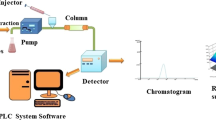Abstract
Reactive extraction is an emerging technology for large-scale continuous resolution of drug enantiomers. The enantioselective extraction of R,S-naproxen by hydrophilic HP-β-CD in 1,2-dichloroethane was studied at 5 °C. The experimental data were described by a reactive extraction model with a homogeneous aqueous phase reaction of R,S-naproxen with HP-β-CD which couples a complete description of chemical equilibria in aqueous phase with the overall phase equilibria of the system. Important parameters of this model were determined experimentally. The physical distribution coefficients for molecular and ionic NAP were 0.041 and 1.730, respectively. Here we show that the efficiency of extraction depends strongly on two process variables including pH and HP-β-CD concentration. The model predictions are compared graphically with the results of previous experiments and there is a good agreement between each other. By the use of modeling and experiment, an optimized extraction condition with pH of 2.5 and HP-β-CD concentration of 0.1 mol/L was obtained with high enantioselectivity (α?) of 1.59 and performance factor (pf) of 0.049. The model gives a good means of predicting enantiomers partitioning over a range of experimental conditions.
Similar content being viewed by others
References
Hutt AJ. Drug chirality: impact on pharmaceutical regulation. Chirality, 1991, 3: 161–164
Yokota M, Doki N, Shimizu K. Chiral separation of a racemic compound induced by transformation of racemic crystal structures: DL-glutamic acid. Cryst Growth Des, 2006, 6: 1588–1590
Maier NM, Franco P, Lindner W. Separation of enantiomers: needs, challenges, perspectives. J Chromatogr A, 2001, 906: 3–33
Tan B, Luo GS, Wang JD. Extractive separation of amino acid enantiomers with co-extractants of tartaric acid derivative and aliquat-336. Sep Purif Technol, 2007, 53: 330–336
Colera M, Costero A, Gaviña P, Gil S. Synthesis of chiral 18-crown-6 ethers containing lipophilic chains and their enantiomeric recognition of chiral ammonium picrates. Tetrahedron Asymmetry, 2005, 16: 2673–2679
Pietraszkiewicz M, Koźbia M, Pietraszkiewicz O. Chiral discrimination of amino acids and their potassium or sodium salts by optically active crown ether derived from D-mannose. J Membr Sci, 1998, 138: 109–113
Keurentjes JTF, Nabuurs LWM, Vegter EA. Liquid membrane technology for the separation of racemic mixtures. J Membr Sci, 1996, 113: 351–360
Tang KW, Yi JM, Liu YB, Jiang XY, Pan Y. Enantioselective separation of R,S-phenylsuccinic acid by biphasic recognition chiral extraction. Chem Eng Sci, 2009, 64: 4081–4088
Tang KW, Song LT, Liu YB, Jiang XY, Pan Y. Separation of flurbiprofen enantiomers by biphasic recognition chiral extraction. Chem Eng J, 2010, 158: 411–417
Tang KW, Chen YY, Huang KL. Enantioselective resolution of chiral aromatic acids by biphasic recognition chiral extraction. Tetrahedron: Asymmetry, 2007, 18: 2399–2408
Viegas RC, Afonso CAM, Crespo JG, Coelhoso IM. Modelling of the enantio-selective extraction of propranolol in a biphasic system. Sep Purif Technol, 2007, 53: 224–234
Schuur B, Winkelmam JGM, Heeres HJ. Equilibrium studies on enantioselective liquid-liquid amino acid extraction using a cinchona alkaloid extractant. Ind Eng Chem Res, 2008, 47: 10027–10033
Koska J, Haynes CA. Modelling multiple chemical equilbria in chiral partition systems. Chem Eng Sci, 2001, 56: 5853–5864
Steensma M, Kuipers NJM, de Haanl AB, Kwant G. Influence of process parameters on extraction equilibria for the chiral separation of amines and amino-alcohols with a chiral crown ether. J Chem Technol Biotechnol, 2006, 81: 588–597
Kocabas E, Karakucuk A, Sirit A, Yilmaz M. Synthesis of new chiral calix[4]arene diamide derivatives for liquid phase extraction of α-amino acid methylesters. Tetrahedron: Asymmetry, 2006, 17: 1514–1520
Ameyibor E, Stewart JT. Enantiomeric HPLC separation of selected chiral drugs using native and derivatized β-cyclodextrins as chiral mobile phase additives. J Liq Chromatogr Relat Technol, 1997, 20: 855–869
Zhou SS, Ouyang J, Baeyens WRG, Zhao HC, Yang YP. Chiral separation of four fluoroquinolone compounds using capillary electrophoresis with hydroxypropyl-β-cyclodextrin as chiral selector. J Chromatogr A, 2006, 1130: 296–301
Bechet I, Paques P, Fillet M, Hubert P, Crommen, J. Chiral separation of basic drugs by capillary zone electrophoresis with cyclodextrin additives. Electrophoresis, 1994, 15: 818–823
Surapaneni S, Khalil SKW. Resolution of terfenadine enantiomers by reversed phase-high performance liquid chromatography using β-cyclodextrin as mobile phase additive. J Pharm Biomed Anal, 1996, 14: 1631–1634
Meindersma GW, van Schoonhoven T, Kuzmanovic B, de Haan AB. Extraction of toluene, o-xylene from heptane and benzyl alcohol from toluene with aqueous cyclodextrins. Chem Eng Process, 2006, 45: 175–183
Campiglio A. Determination of naproxen with chemiluminescence detection. Analyst, 1998, 123, 1571–1574
Lelièvre F, Gareil P. Chiral separations of underivatized arylpropionic acids by capillary zone electrophoresis with various cyclodextrins acidity and inclusion constant determinations. J Chromatogr A, 1996, 735: 311–320
Tang KW, Miao JB, Zhou T, Song LT. Equilibrium studies on reactive extraction of naproxen enantiomers using hydrophilicn β-cyclodetrin derivatives extractants. J Incl Phenom Macrocycl Chem, 2010, 27: 1–8
Ning FR, Huang KL, Jiao FP. Study on retention characteristics and separation mechanism of enantiomers of naproxen with HP-β-CD as a mobile phase modifier in HPLC. Chem Online, 2006, 6: 425–429
Author information
Authors and Affiliations
Corresponding author
Rights and permissions
About this article
Cite this article
Tang, K., Zhang, P., Pan, C. et al. Modeling multiple chemical equilibrium for reactive extraction of naproxen enantiomers with HP-β-CD as hydrophilic selector. Sci. China Chem. 54, 1130–1137 (2011). https://doi.org/10.1007/s11426-011-4253-7
Received:
Accepted:
Published:
Issue Date:
DOI: https://doi.org/10.1007/s11426-011-4253-7




